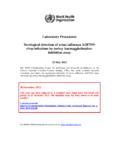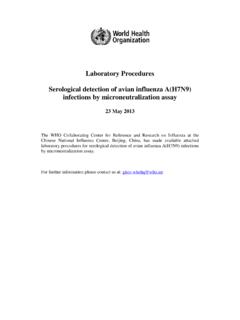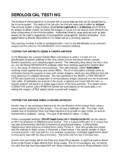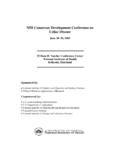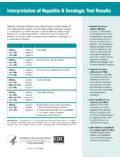Transcription of SAFETY DATA SHEET - serological.com
1 serological Research Institute (SERI). SAFETY data SHEET . SECTION 1: PRODUCT AND COMPANY IDENTIFICATION. Product identifiers: R558a AP Spot Test Recommended Use: Forensic, Research Company Info: serological Research Institute (SERI), 3053 Research Drive, Richmond, CA 94806 USA. Phone: 1-510-223-7374 Fax: 1-510-222-8887. Emergency Phone: 911, American Association of Poison Control Centers: 1-800-222-1222. SECTION 2: HAZARDS IDENTIFICATION. Classification of the substance or mixture GHS Classification in accordance with 29 CFR 1910 (OSHA HCS). Acute toxicity, Oral (Category 4), H302. Skin irritation (Category 2), H315. Eye irritation (Category 2A), H319. Skin sensitisation (Category 1), H317. Specific target organ toxicity - single exposure (Category 3), Respiratory system, H335. Carcinogenicity (Category 1B), H350. Acute aquatic toxicity (Category 3), H402. For the full text of the H-Statements mentioned in this Section, see Section 16. GHS Label elements, including precautionary statements Pictogram Signal word: Danger, Irritant, Warning Hazard statement(s).
2 H302 Harmful if swallowed. H315 Causes skin irritation. H317 May cause an allergic skin reaction. H319 Causes serious eye irritation. H335 May cause respiratory irritation. H350 May cause cancer. H402 Harmful to aquatic life. Precautionary statement(s). P201 Obtain special instructions before use. P202 Do not handle until all SAFETY precautions have been read and understood. P261 Avoid breathing dust/ fume/ gas/ mist/ vapors/ spray. P281 Use personal protective equipment as required. P264 Wash skin thoroughly after handling. P270 Do not eat, drink or smoke when using this product. P271 Use only outdoors or in a well-ventilated area. P272 Contaminated work clothing should not be allowed out of the workplace. P273 Avoid release to the environment. P280 Wear eye protection/ face protection. P280 Wear protective gloves. P301 + P312 + P330 IF SWALLOWED: Call a POISON CENTER or doctor/ physician if you feel unwell. Rinse mouth. P302 + P352 IF ON SKIN: Wash with plenty of soap and water.
3 P304 + P340 + P312 IF INHALED: Remove victim to fresh air and keep at rest in a position comfortable for breathing. Call a POISON CENTER or doctor/ physician if you feel unwell. P305 + P351 + P338 IF IN EYES: Rinse cautiously with water for several minutes. Remove contact lenses, if present and easy to do. Continue rinsing. P308 + P313 IF exposed or concerned: Get medical advice/ attention. P333 + P313 If skin irritation or rash occurs: Get medical advice/ attention. P337 + P313 If eye irritation persists: Get medical advice/ attention. P362 Take off contaminated clothing and wash before reuse. P403 + P233 Store in a well-ventilated place. Keep container tightly closed. P405 Store locked up. P501 Dispose of contents/ container to an approved waste disposal plant. Hazards not otherwise classified (HNOC) or not covered by GHS - none SECTION 3: COMPOSITION/INFORMATION ON INGREDIENTS. Mixtures: Alpha-Naphthyl Acid Phosphate Monosodium Salt, Synonyms: Not available, Formula : C10H8O4 PNa, CAS No.
4 : 81012- 89-7, EC-No. : 264-899-3. Fast Blue B Salt, Synonyms: Diazo Blue B, Naphthanil Diazo Blue B, o-Dianisidine bis(diazotized) zinc double salt, Azoic Diazo No. 48, Formula: C14H12Cl4N4O2Zn, Molecular weight: g/mol, CAS-No. : 14263-94-6. Maleic acid, Synonyms : Toxilic acid, cis-Butenedioic acid, Formula : C4H4O4, Molecular weight : g/mol, CAS-No. : 110-16-7, EC-No. : 203-742-5, Index-No. : 607-095-00-3. Sodium phosphate dibasic, Synonyms: Disodium hydrogen phosphate, sec-Sodium phosphate, Disodium phosphate, Sodium hydrogenphosphate, Formula : HNa2O4P, Molecular Weight : g/mol, CAS-No. : 7558-79-4, EC-No. : 231- 448-7. Hazardous Components: o-Dianiside CAS-No. 119-90-4, EC-No. 204-355-4, Index-No. 612-036-00-X, Acute Tox. 4;. Carc. 1B; H302, H350, Maleic acid Acute Tox. 4; Skin Irrit. 2; Eye Irrit. 2A; Skin Sens. 1; STOT SE 3; Aquatic Acute 3;. H302, H315, H317, H319, H335, H402. Component Percentage/Concentration has been withheld as a trade secret. SECTION 4: FIRST AID MEASURES.
5 Description of first aid measures General advice: Move out of dangerous area. Consult a physician. Show this SAFETY data SHEET to the doctor in attendance. If inhaled: If breathed in, move person into fresh air. If not breathing, give artificial respiration. Consult a physician. In case of skin contact: Wash off with soap and plenty of water. Consult a physician. In case of eye contact: Rinse thoroughly with plenty of water for at least 15 minutes and consult a physician. If swallowed: Never give anything by mouth to an unconscious person. Rinse mouth with water. Consult a physician. Most important symptoms and effects, both acute and delayed: The most important known symptoms and effects are described in the labelling (see section ) and/or in section 11. Indication of any immediate medical attention and special treatment needed: No data available SECTION 5: FIREFIGHTING MEASURES. Extinguishing media Suitable extinguishing media: Use water spray, alcohol-resistant foam, dry chemical or carbon dioxide.
6 Special hazards arising from the substance or mixture: Carbon oxides, Hydrogen chloride gas, Oxides of phosphorus, Nitrogen oxides (NOx), Sodium oxides, Zinc/zinc oxides Advice for firefighters: Wear self-contained breathing apparatus for firefighting if necessary. Further information: No data available SECTION 6: ACCIDENTAL RELEASE MEASURES. Personal precautions, protective equipment and emergency procedures: Use personal protective equipment. Avoid dust formation. Avoid breathing vapors, mist or gas. Ensure adequate ventilation. Evacuate personnel to safe areas. Avoid breathing dust. For personal protection see section 8. Environmental precautions: Prevent further leakage or spillage if safe to do so. Do not let product enter drains. Discharge into the environment must be avoided. Methods and materials for containment and cleaning up: Pick up and arrange disposal without creating dust. Sweep up and shovel. Keep in suitable, closed containers for disposal. Reference to other sections: For disposal see section 13.
7 SECTION 7: HANDLING AND STORAGE. Precautions for safe handling: Avoid formation of dust and aerosols. Further processing of solid materials may result in the formation of combustible dusts. The potential for combustible dust formation should be taken into consideration before additional processing occurs. Provide appropriate exhaust ventilation at places where dust is formed. Keep away from heat. Keep away from sources of ignition. For precautions see section Conditions for safe storage, including any incompatibilities: Recommended storage temperature: Frozen. Hygroscopic. Keep container tightly closed in a dry and well-ventilated place. Keep in a dry place. Storage class (TRGS 510): Non Combustible Solids Specific end use(s): Apart from the uses mentioned in section no other specific uses are stipulated SECTION 8: EXPOSURE CONTROLS/PERSONAL PROTECTION. Control parameters: Components with workplace control parameters: Contains no substances with occupational exposure limit values.
8 Exposure controls Appropriate engineering controls: Handle in accordance with good industrial hygiene and SAFETY practice. Wash hands before breaks and at the end of workday. Personal protective equipment: Eye/face protection, SAFETY glasses with side-shields conforming to EN166 Use equipment for eye protection tested and approved under appropriate government standards such as NIOSH (US) or EN 166(EU). Skin protection: Handle with gloves. Gloves must be inspected prior to use. Use proper glove removal technique (without touching glove's outer surface) to avoid skin contact with this product. Dispose of contaminated gloves after use in accordance with applicable laws and good laboratory practices. Wash and dry hands. Full contact: Material: Nitrile rubber, Minimum layer thickness: mm, Break through time: 480 min, Material tested:Dermatril (KCL 740 / Aldrich Z677272, Size M). Splash contact: Material: Nitrile rubber, Minimum layer thickness: mm, Break through time: 480 min, Material tested:Dermatril (KCL 740 / Aldrich Z677272, Size M).
9 data source: KCL GmbH, D-36124 Eichenzell, phone +49 (0)6659 87300, e-mail test method: EN374. If used in solution, or mixed with other substances, and under conditions which differ from EN 374, contact the supplier of the CE approved gloves. This recommendation is advisory only and must be evaluated by an industrial hygienist and SAFETY officer familiar with the specific situation of anticipated use by our customers. It should not be construed as offering an approval for any specific use scenario. Body Protection: Impervious clothing. Complete suit protecting against chemicals. The type of protective equipment must be selected according to the concentration and amount of the dangerous substance at the specific workplace. Respiratory protection: For nuisance exposures use type P95 (US) or type P1 (EU EN 143) particle higher level protection use type OV/AG/P99 (US) or type ABEK-P2 (EU EN 143) respirator cartridges. Where risk assessment shows air-purifying respirators are appropriate use a full-face particle respirator type N100 (US) or type P3 (EN 143).
10 Respirator cartridges as a backup to engineering controls. If the respirator is the sole means of protection, use a full-face supplied air respirator. Use respirators and components tested and approved under appropriate government standards such as NIOSH (US) or CEN (EU). Control of environmental exposure: Prevent further leakage or spillage if safe to do so. Do not let product enter drains. Discharge into the environment must be avoided. SECTION 9: PHYSICAL AND CHEMICAL PROPERTIES. Information on basic physical and chemical properties a) Appearance Form: Powder, Color: White/Grey/Tan, b) Odor: No data available, c) Odor Threshold: No data available, d) pH: No data available, e) Melting point/freezing point: Melting point/range: 137 - 140 C (279 - 284 F) - lit., f) Initial boiling point and boiling range: 160 C (320 F), g) Flash point: 127 C (261 F) - closed cup, h) Evaporation rate: No data available, i) Flammability (solid, gas): No data available, j) Upper/lower flammability or explosive limits: Lower explosion limit: %(V), k) Vapor pressure: No data available, l) Vapor density: No data available, m) Relative density: No data available, n) Water solubility: soluble, o) Partition coefficient: noctanol/water: No data available, p) Auto-ignition temperature: No data available, q) Decomposition temperature: No data available, r) Viscosity: No data available, s).


